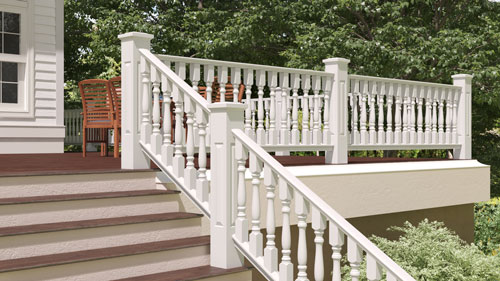Step into Beauty: Deck Railing Choices for Every Homeowner
Wiki Article
Safety And Security and Style: Exploring Various Deck Railing Layouts
When it comes to deck style, layout and safety go hand in hand,. Deck railings not only give required defense, but additionally add aesthetic interest outdoor rooms. This article digs right into the world of deck barrier layouts, exploring different alternatives that combine both security and design. From conventional styles that exude ageless style to contemporary choices that use a sleek and contemporary appearance, there is a wide variety of options readily available to suit different tastes and choices. In addition, minimal designs offer a clean and downplayed visual, while luxuriant layouts add a touch of splendour. Nature-inspired styles effortlessly mix exterior components with functionality. By analyzing these different railing designs, homeowners and developers alike can make enlightened decisions to produce beautiful and safe and secure deck spaces - Deck Railing.Standard Deck Railing Designs
Standard deck railing layouts supply a timeless and classic aesthetic for house owners seeking to enhance the security and style of their exterior areas. These layouts usually include vertical or horizontal balusters made from steel, wood, or glass, supported by sturdy messages. Using traditional materials such as wood adds a rustic appeal to the deck, developing a warm and inviting ambience.One popular conventional deck railing layout is the wood baluster barrier. This style makes use of wooden balusters, which are equally spaced in between two straight rails. The wood balusters can be intricately sculpted or left plain, relying on the home owner's choice. This layout not only gives a complacency yet also includes a touch of beauty to the deck.

Last but not least, glass railing designs are becoming increasingly preferred in typical deck designs. Glass railings supply an unblocked sight of the bordering landscape while keeping the deck protected. They can be framed with timber or metal, including a contemporary touch to the conventional style.
Contemporary Deck Barrier Designs
Contemporary deck railing layouts use property owners a contemporary and fresh method to improving the safety and design of their exterior areas. These designs are characterized by smooth lines, minimal looks, and making use of innovative products. One popular contemporary railing style is the cable television barrier. This layout includes thin stainless-steel cables that are stretched flat or vertically between blog posts, creating a unobstructed and aesthetically open view. Another prominent alternative is the glass barrier, which makes use of tempered glass panels held in place by steel or wooden frameworks. This style permits for optimum visibility while supplying a smooth and sophisticated look. In addition, house owners can select metal railing styles, such as light weight aluminum or stainless steel, which provide sturdiness and a modern commercial feel. These railing designs can be customized with different surfaces, such as powder finishing or anodizing, to match the overall aesthetic of the outside space. Overall, modern deck barrier designs supply an excellent mix of safety, design, and performance, redirected here making them a prominent option among property owners aiming to produce a aesthetically enticing and modern outside setting.Minimalist Deck Barrier Designs
One prominent minimalist deck barrier style features a slim steel framework with upright balusters. This style is characterized by its simplicity and tidy lines, making it a popular option for homeowners who favor a minimal visual. The slim metal frame supplies a modern-day and streamlined appearance, while the upright balusters add aesthetic interest and make sure the safety and security of the deck.The slim steel frame used in this layout is commonly made of materials such as light weight aluminum or stainless steel. These products are not just durable and lasting explanation however also immune to rust and rust, making them optimal for outside usage. In addition, the slim profile of the metal frame enables unhampered sights of the surrounding landscape, boosting the general pleasure of the deck.
The upright balusters made use of Get More Information in this design are evenly spaced along the steel framework, supplying a sense of rhythm and equilibrium. These balusters can be made from numerous materials, such as steel, glass, or also wood, depending upon the home owner's preference. The choice of material for the balusters can further improve the minimal visual or add a touch of heat and appearance to the style.
Ornate Deck Barrier Layouts
A luxurious deck barrier design integrates detailed describing and elegant materials to produce a aesthetically striking and elegant visual. Luxuriant deck barrier styles usually include intricate patterns, contours, and concepts that include a touch of class to any kind of outdoor space (Deck Railing). These styles are characterized by their use decorative elements such as scrolls, floral patterns, and ornamental accents that are meticulously crafted to boost the overall elegance of the barrierWhen it involves materials, elaborate deck barriers are normally made from premium products such as functioned iron, bronze, or stainless steel. These materials not just supply durability and toughness but additionally offer a feeling of majesty to the railing layout. Detailed describing can be attained via techniques like welding, casting, or building, enabling for the creation of captivating and distinct patterns.
Along with their aesthetic appeal, elaborate deck railings also supply practical advantages. The elaborate styles commonly include decorative blog posts and balusters that offer extra assistance and stability, ensuring the safety of those utilizing the deck.
Nature-Inspired Deck Railing Styles
The incorporation of all-natural components into deck barrier styles includes a revitalizing and organic touch to outside spaces. Nature-inspired deck railing styles attract inspiration from the beauty and tranquility of the environment, creating an unified connection in between the built atmosphere and the surrounding landscape.One preferred nature-inspired style is making use of wooden balusters or articles. The cozy and earthy tones of wood blend effortlessly with the outdoor environments, developing a feeling of all-natural charm. Furthermore, the natural textures and grains of timber add deepness and personality to the overall design.
An additional nature-inspired alternative is using planters or flower boxes as barrier improvements. These can be incorporated into the railing framework, permitting the development of lively flowers, herbs, or other plants. This not just adds a touch of plant to the room however likewise creates a feeling of privacy and enclosure.

Final Thought
Standard styles provide a timeless appearance, while modern designs offer a sleek and modern visual. Minimal styles concentrate on simpleness and tidy lines, while elaborate designs add a touch of beauty.In addition, minimalist designs provide a tidy and understated aesthetic, while ornate designs add a touch of splendour.An additional typical deck railing style is the steel barrier.Lastly, glass barrier designs are coming to be significantly popular in traditional deck styles. Standard layouts use a classic appearance, while modern styles offer a smooth and contemporary aesthetic. Minimal layouts focus on simpleness and tidy lines, while ornate layouts include a touch of sophistication.
Report this wiki page